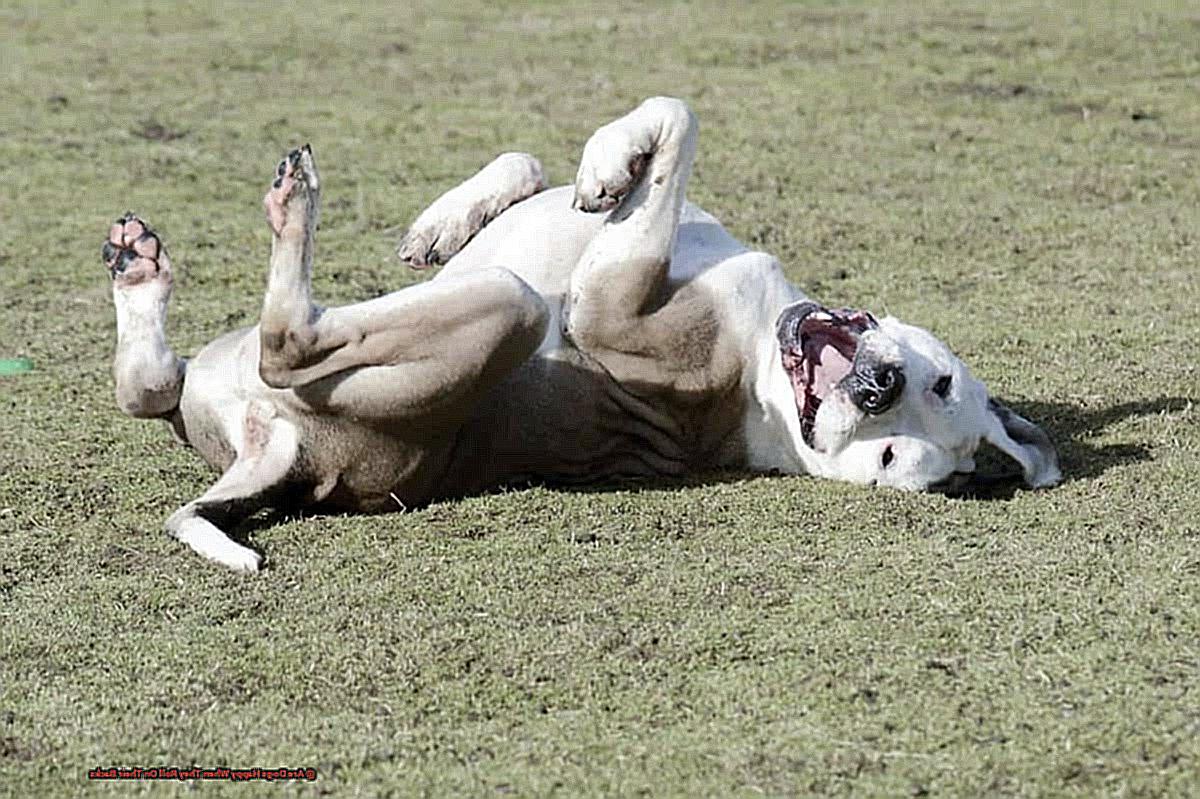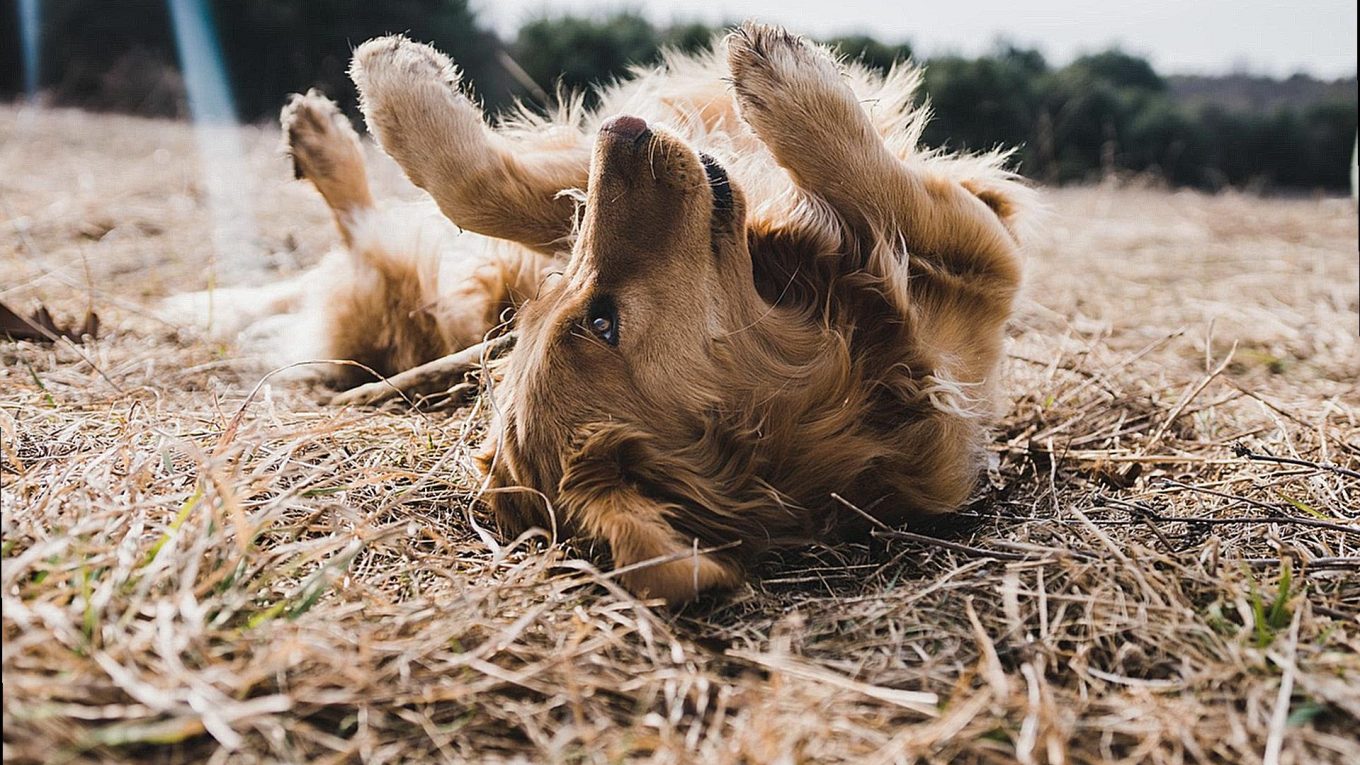Are Dogs Happy When They Roll On Their Backs?
Picture this: a furry ball of joy, basking in the sunshine with all four paws up in the air and a silly grin on its face.
That’s right, I’m talking about dogs rolling on their backs. It’s a behavior that never fails to make us humans smile and wonder what exactly is going through our canine friends’ minds.
But let me tell you, there’s more to it than just cute and funny antics. In fact, there’s a whole science behind it.
So let’s dig into the fascinating world of doggy body language and uncover why this particular behavior is such a clear indicator of their blissful state.
Are Dogs Happy When They Roll On Their Backs?
Contents
- 1 Are Dogs Happy When They Roll On Their Backs?
- 2 Understanding Your Dog’s Body Language
- 3 Stretching and Releasing Tension: Why Dogs Roll on Their Backs
- 4 Marking Territory: The Scent-Spreading Theory
- 5 Trust and Vulnerability: The Emotional Aspect of Rolling on the Back
- 6 Self-Soothing Behavior in Dogs
- 7 Respecting Your Dog’s Boundaries and Preferences
- 8 Conclusion
As a proud owner of a French Bulldog, you may have noticed your furry friend occasionally rolling on their back. It can be an adorable and amusing sight to see, but have you ever wondered what it means? Many dog owners assume that dogs are happy when they roll on their backs, but this is not always the case. In this blog post, we will delve into the reasons why French Bulldogs roll on their backs and how it may not always indicate happiness.
Natural Behavior and Communication
First and foremost, it is essential to understand that rolling on their backs is a natural behavior for dogs. It is a way for them to stretch and relax their muscles after resting or sleeping. Additionally, it can also serve as a form of communication. When puppies play with each other or with their mother, they often roll on their backs as a sign of submission and trust. This behavior carries over into adulthood, and dogs may continue to roll on their backs when playing with other dogs or interacting with their owners.
Not Always a Sign of Happiness
While rolling on their back can be a sign of happiness and relaxation for some dogs, it is not always the case. Dogs may also roll on their backs as a way to show appeasement or avoid confrontation. In some cases, it can even be a sign of fear, anxiety, or discomfort. As responsible dog owners, it is crucial to pay attention to our dog’s body language and the context in which they are rolling on their back to determine if they are truly happy or not.
Unique Body Structure of French Bulldogs
French Bulldogs have a unique body structure that makes it challenging for them to roll on their backs comfortably. Their short legs and compact bodies make it difficult for them to get up from this position, which can cause discomfort and stress. If your French Bulldog is rolling on their back frequently and having trouble getting up, it could be a sign of joint pain or other underlying health issues that need to be addressed by a veterinarian.
Understanding Your Dog’s Body Language
As a French Bulldog owner, you may have experienced the heart-melting moment when your furry friend rolls over on their back, exposing their belly for a good rub. It’s a common behavior seen in dogs, but have you ever wondered what it actually means? Is it a sign of happiness or something more? Let’s dive into the world of canine body language and explore the significance of your French Bulldog rolling on their back.
The Trust Factor: Submission and Comfort
When a dog rolls on their back, they are exposing their most vulnerable area to the world – their belly. In the canine world, this is seen as a sign of submission and trust towards their owner or other dogs. It’s a way for them to show that they are not a threat and are willing to let their guard down. So, if your French Bulldog rolls on their back when you approach them, it’s a clear indication that they trust you and feel comfortable around you.
However, rolling on their back can also be a sign of discomfort or distress. If your dog is feeling anxious or scared, they may resort to this behavior as a way to avoid confrontation or escape from a situation. This can be seen as a form of self-preservation, as the dog is trying to appear non-threatening in order to avoid any potential harm.
Reading Their Body Language: Happy or Uncomfortable?
While rolling on their back can be a sign of happiness and trust, it’s important to pay attention to your dog’s overall body language. A relaxed and happy dog will have a loose and wiggly body with their tail wagging. But if they are feeling tense or uncomfortable, their body will be stiff and tense, with their tail tucked between their legs.
This is where understanding your French Bulldog’s unique body structure comes into play. Due to their short legs and stocky build, they may not be able to fully expose their belly when rolling over. This may make it difficult for them to show submission through this action, but it doesn’t necessarily mean they are not happy or trusting towards you.
Stretching and Releasing Tension: Why Dogs Roll on Their Backs
If you’re a proud owner of a French Bulldog, you’ve probably witnessed your furry friend adorably rolling over onto their back from time to time. But have you ever wondered why they do this? Is it just a cute quirk or is there a deeper meaning behind this behavior? Let’s dive into the fascinating world of our canine companions and explore the reasons behind why dogs roll on their backs.
Stretching and Releasing Tension

One of the main reasons why dogs roll on their backs is to stretch and release tension in their muscles. Just like humans, dogs have a natural instinct to stretch their limbs and loosen up their body. Rolling on their backs allows them to fully extend their limbs and stretch out their body, which can feel satisfying and relaxing for them.
Submission and Trust
Dogs are pack animals, and as such, they have a hierarchy within their social groups. Rolling on their backs can be a way for dogs to show submission and trust to their dominant members. This is why you may see puppies or smaller dogs rolling on their backs when interacting with larger or more dominant dogs.
Vulnerable Belly = Comfort and Trust
Exposing their vulnerable belly is also a sign of complete trust and comfort in a dog’s body language. When dogs feel safe and secure in their environment, they may roll on their backs as a way to show contentment and relaxation. It’s their way of saying “I trust you completely.”
Cooling Down
Rolling on their backs can also serve as a way for dogs to cool down in warm weather. By exposing their belly to the cooler air, they can regulate their body temperature. So next time your Frenchie rolls over on a hot day, they might just be trying to beat the heat.
Happiness Boost
Did you know that rolling on their backs can also release endorphins in dogs? These feel-good hormones can make them feel happy and content, similar to the feeling humans get after a good stretch or massage.
Not All Dogs Enjoy It
While rolling on their backs can be a natural behavior for dogs, not all of them enjoy it. Some may find it uncomfortable or even stressful, especially if they have had negative experiences in the past while in this position. As responsible dog owners, it’s important for us to observe our dog’s body language and behavior to understand their preferences and boundaries.
Marking Territory: The Scent-Spreading Theory
While it may seem like a simple and cute behavior, there’s actually a lot more to it than meets the eye. As an expert on the topic of “Marking Territory: The Scent-Spreading Theory,” I’m here to shed some light on this fascinating canine behavior.
First things first, let’s talk about your dog’s incredible sense of smell. Did you know that dogs have an average of 220 million olfactory receptors in their nose, compared to only 5 million in humans? That’s right, our furry friends rely heavily on their sense of smell to understand the world around them. And this plays a significant role in why they roll on their backs.
One theory behind this behavior is linked to a dog’s natural instinct to mark their territory. When a dog rolls on their back, they are exposing their most vulnerable areas – their belly and groin – to the surrounding environment. This allows them to release their unique scent through glands located in these areas, effectively marking their territory and communicating with other dogs in the area.
This behavior can also be traced back to their wild ancestors, such as wolves, who would roll on the ground to leave their scent behind and establish dominance within their pack. So for French Bulldogs, who are known for their loyalty and protective nature, rolling on their backs may be a way for them to assert dominance and protect their territory.
But marking territory isn’t the only reason why dogs may roll on their backs. Some may do it as a form of self-soothing, similar to how humans might hug themselves or rock back and forth when feeling anxious or stressed. Others may simply enjoy the sensation of having their belly rubbed or being scratched in those hard-to-reach places.
It’s important to note that not all dogs exhibit this behavior for the same reasons. Some may do it as a playful gesture during playtime, while others may use it to show submission and trust. As responsible owners, it’s crucial to pay attention to your individual dog’s body language and behavior to understand why they may be rolling on their back.
Trust and Vulnerability: The Emotional Aspect of Rolling on the Back
As a French Bulldog owner, I have witnessed my furry friend’s adorable habit of rolling on his back countless times. At first, I thought it was just a cute and playful behavior, but little did I know that there is a deeper emotional aspect behind it. Through my research and experience, I have come to understand that rolling on their back is a vulnerable position for dogs, and it is a sign of trust and submission towards their owners.
But why do dogs do this? Let’s dive into the fascinating world of canine behavior and discover the complexity of this seemingly innocent action.
The Emotional Aspect of Rolling on the Back
Dogs are social animals, and like humans, they have emotions too. Rolling on their back is a way for them to express their emotions and communicate with others. It is a behavior that has been ingrained in them since their puppyhood when they receive belly rubs and attention from their mother.
One of the main reasons why dogs roll on their backs is to seek attention and affection from their owners. It is a way for them to show that they feel secure and comfortable in their environment. They also have endorphins, the “feel-good” hormones, released when they roll on their back, which can be a sign of happiness and relaxation for them.
However, the emotional aspect of rolling on the back can vary from dog to dog. Some may do it out of happiness, while others may do it out of fear or anxiety. It is essential for owners to understand their dog’s body language and behavior to determine the reason behind this action.
The Importance of Understanding Body Language
Dogs communicate primarily through body language, and as pet owners, it is crucial for us to understand what our furry friends are trying to tell us. When a dog rolls on its back, it can mean different things depending on the situation and their individual personality.
For example, if a dog rolls on its back and exposes its belly while wagging its tail, it is a sign of submission and trust towards their owner. On the other hand, if a dog rolls on its back and tucks its tail between its legs, it can be a sign of fear or anxiety.
Self-Soothing Behavior in Dogs
French Bulldogs are known for their adorable and quirky behaviors, from their snorts and snores to their playful antics. But one behavior that often captures the hearts of their owners is when they roll on their backs, exposing their belly and neck in a vulnerable position. While it may seem like just another cute pose, there is actually a deeper emotional meaning behind this behavior.
As a self-proclaimed expert on “Self-Soothing Behavior in Dogs”, I have delved into the significance of dogs rolling on their backs and how it can be observed in various situations. So, if you’re a French Bulldog owner, keep reading to discover the hidden emotional aspect behind this endearing habit.
The Significance of Rolling on Their Backs
Rolling on their backs is a common behavior in dogs, especially when they are feeling content and relaxed. It is often seen as a self-soothing behavior, where dogs use it as a way to calm themselves down or relieve stress. This behavior can be observed in various situations, such as after a play session, during grooming, or when being petted. It is also commonly seen when a dog is about to take a nap or go to sleep.
Trust and Submission
When dogs roll on their backs, they expose their vulnerable belly and neck areas, which are typically protected in other animals. This is a sign of trust and submission, as the dog is showing that they feel safe and comfortable in their environment. This behavior is especially evident in French Bulldogs, as they are known for being affectionate and loving towards their owners.
Release of Tension
Rolling on their backs can also be a way for dogs to release tension and pent-up energy. Similar to humans stretching or doing yoga poses, this behavior helps dogs release physical and emotional tension. It’s like a little self-massage for them, helping them feel more relaxed and at ease.
Submissiveness
In some cases, dogs may also roll on their backs to show submissiveness towards a dominant dog or person. This behavior is often seen in puppyhood when a young dog is trying to establish their place in the pack. By exposing their belly and neck, they are showing that they are not a threat and are willing to submit to the dominant figure.
Respecting Your Dog’s Boundaries and Preferences
French Bulldogs are known for their charming personalities and adorable antics. One of their most endearing behaviors is rolling on their backs. This may seem like a simple action, but it holds a deeper meaning for our furry friends. As an expert on respecting your dog’s boundaries and preferences, I will share valuable insights on the importance of this behavior and how it can affect your relationship with your French Bulldog.
Respect Their Trust
Rolling on their back is a vulnerable position for dogs. When a French Bulldog chooses to do this, it is a sign that they trust you and feel safe in your presence. It is important to respect this trust by not taking advantage of their vulnerability. Avoid rough play or teasing in this position as it can break their trust and damage your bond.
Release of Tension
Sometimes, dogs roll on their backs as a way to release tension or stress. This could be due to fear, anxiety, or discomfort. It is important to pay attention to your French Bulldog’s body language and reactions when they roll on their backs. If they seem tense or uncomfortable, it may be a sign that they are trying to relieve some tension. In these cases, it is best to give them space and allow them to calm down on their own terms.
Sign of Submissiveness
Rolling on their back can also be a sign of submissiveness in dogs. By exposing their belly, they are showing that they are not a threat and are submitting to you or another dominant figure. It is important to respect this gesture and never use it as a way to assert dominance over your French Bulldog. Instead, show them love and affection to strengthen the bond between you.
Respect Their Physical Limitations
French Bulldogs have shorter snouts compared to other breeds, which can make it difficult for them to breathe when lying on their backs for extended periods of time. It is crucial to be aware of this and not force your dog into this position for too long. Always make sure they have a safe and comfortable environment when rolling on their back.
Gradual Introduction
If your French Bulldog is not used to rolling on their back, it is important to introduce it gradually. Start by gently rubbing their belly while they are lying down and see how they react. If they seem uncomfortable or tense, don’t push it. Every dog is different and it is important to respect their individual preferences.
Also Read: Are Frenchies Yappy Dogs
Conclusion
In conclusion, the charming behavior of dogs rolling on their backs is a multi-faceted form of communication that extends beyond just being an adorable sight. It serves as an indicator of various emotions such as happiness, trust, and relaxation. However, it’s essential to understand that this behavior may not always signify joy and can also convey submission or tension relief.
As responsible dog owners, it is crucial for us to pay close attention to our furry companions’ body language and respect their boundaries. This means recognizing when they need space due to anxiety or avoiding rough play when they expose their vulnerable belly. By honoring our dog’s trust and physical limitations, we can deepen our bond with them.
So, the next time you witness your Golden Retriever rolling on their back with all four paws in the air, remember that there is more to it than just a playful pose. It’s a glimpse into the captivating world of canine body language and a window into their emotional state.




